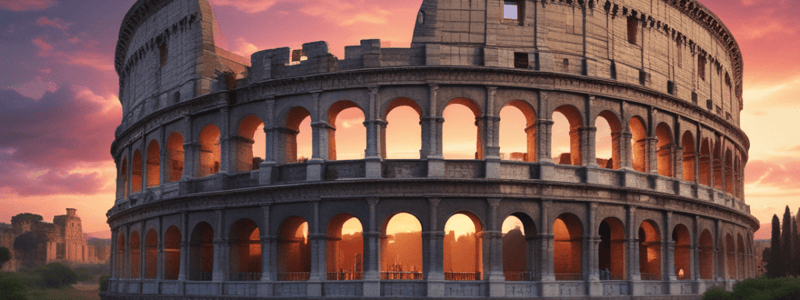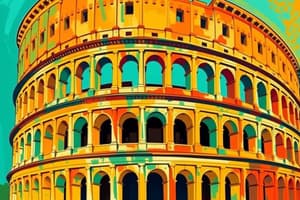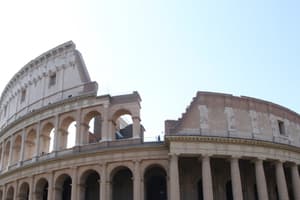Podcast
Questions and Answers
What was the primary purpose of the Colosseum in ancient Rome?
What was the primary purpose of the Colosseum in ancient Rome?
- It was a marketplace for trading goods.
- It was used for gladiatorial contests and other public spectacles. (correct)
- It served as a palace for the Roman emperors.
- It was a temple dedicated to the Roman gods.
What is the origin of the name 'Colosseum'?
What is the origin of the name 'Colosseum'?
- It was named for its colossal size and capacity.
- It was named after the Roman emperor who commissioned its construction.
- It was named after the Roman god of architecture, Colossus.
- It was derived from the Colossus of Nero, a statue near the site. (correct)
What was the primary function of Roman arches in architecture?
What was the primary function of Roman arches in architecture?
- They were used as platforms for public speeches.
- They were used for decorative purposes.
- They were used as entrances to important buildings.
- They were used to support underground drainage systems and as structural elements. (correct)
What was the primary purpose of Roman aqueducts?
What was the primary purpose of Roman aqueducts?
Which of the following is a prominent example of a Roman temple?
Which of the following is a prominent example of a Roman temple?
What was the primary function of the Roman Forum?
What was the primary function of the Roman Forum?
Flashcards are hidden until you start studying
Study Notes
Roman Architecture
Colosseum
The Colosseum, located in Rome, Italy, is one of the most famous landmarks of the Roman Empire. Built between 70-80 AD, it is considered the largest amphitheater ever constructed. Its name is derived from the Colossus of Nero, a statue of the emperor Nero that once stood nearby. The Colosseum was used for gladiatorial contests, mock sea battles, animal hunts, executions, re-enactments of famous battles, and dramas based on Classical mythology. It is estimated that the Colosseum could hold between 50,000 and 80,000 spectators, depending on the event.
Roman Arches
Arches played a vital role in Roman architecture. Initially used to support underground drainage systems, arches later became the primary structural element for recording significant events, such as the Arch of Constantine, one of the oldest surviving arches from the Roman era. The Arch of Titus is another prominent example. These monuments marked important victories and celebrated the achievements of the empire.
Aqueducts
Aqueducts were an essential component of Roman infrastructure, providing water to urban areas. These structures were built primarily from limestone masonry, with arches supporting viaduct sections. Their design enabled the transport of water from remote sources to populated centers, contributing significantly to the growth and prosperity of cities.
Pantheon
The Pantheon in Rome is one of the most recognizable Roman temples. Originally dedicated to all the gods of pagan Rome, it now serves as a Catholic church. The Pantheon is renowned for its dome, which is unreinforced concrete and measures approximately 43 meters in diameter. This dome has no visible internal supports, and its oculus allows natural light to enter the building.
Forum
Forums were the heart of Roman life. They served as public meeting places where citizens could gather to conduct business transactions, attend trials, participate in political debates, and engage in social interactions. The size and importance of a city were often measured by the extent and quality of its forum.
Studying That Suits You
Use AI to generate personalized quizzes and flashcards to suit your learning preferences.




